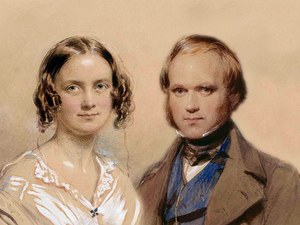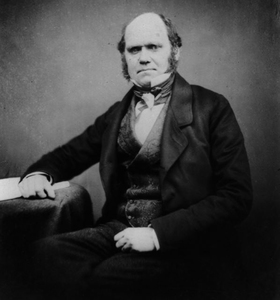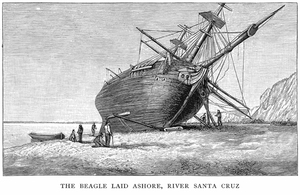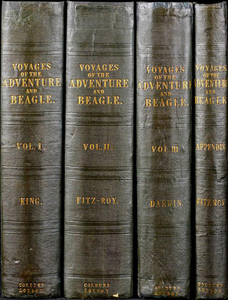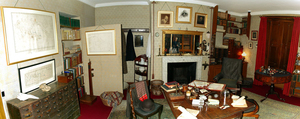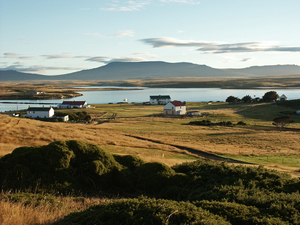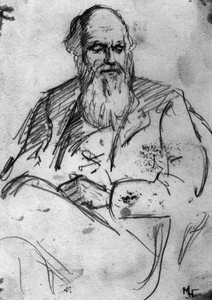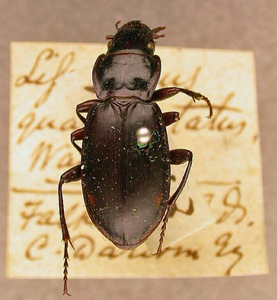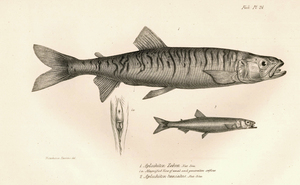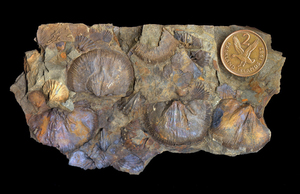DARWIN, CHARLES ROBERT
1809 - 1882 from England
scientist, was born in Shrewsbury on 9 February 1809, the son of Robert Darwin, a fashionable and prosperous doctor, and Susannah Darwin, née Wedgwood.
He was the grandson of Erasmus Darwin - physician, poet, philosopher, polymath, who espoused evolutionary concepts long before his grandson developed the integrated theory of evolution through natural selection. The family tended towards nonconformity and the Whig tradition in politics. Charles's mother died when he was eight and in later life he said he had little recollection of her. His father, besides being an eminent physician must have had a dominating presence; he was 6ft2in (1·88m) in height, and at one stage weighed over 24 stone (150kg). The young Charles was extremely fond of him, and later wrote that he was the kindest man he ever knew. However, Dr Darwin's attempts to influence the direction of his son's career led, from time to time, to a certain amount of conflict.
After a year at a small school, the young Darwin went to Shrewsbury School. He did not perform well academically, and left the school, not altogether unwillingly, at the age of 16. Thereafter, for a few months in the summer of 1825 he served as a sort of apprentice to his doctor father, helping with patients and the preparation of medicines, before he was dispatched to Edinburgh Medical School, where his elder brother Erasmus was completing his training. Darwin detested the medical training: but he attended a few (rather unexciting) lectures on geology and made contact with the freethinking Dr Robert Grant, a comparative anatomist and specialist in the zoology of marine life, and enjoyed beachcombing along the coast of the Firth of Forth looking for seashore life. The sight of operations (performed in those days without anaesthetic) appalled him, and after two years he left Edinburgh unqualified. His father was disappointed.
It was decided that although it was rather outside family tradition, he might make a Church of England parson; he was therefore sent to Christ's College Cambridge to take a general degree in Arts. There a modicum of theology, philosophy, mathematics and New Testament Greek was studied, good food eaten, wine consumed and friends made. He went beetle-collecting with his cousin, William Darwin Fox. Particularly important influences at Cambridge were his friendships with the young don, the Reverend John Stevens Henslow, Professor of Botany, with whom he used to go for walks into the Cambridgeshire countryside, and with the Reverend Adam Sedgwick, Professor of Geology. Both encouraged his interest in natural history. In 1831 Darwin graduated as Bachelor of Arts and that summer Sedgwick took him on a geological expedition through North Wales.
Darwin used, in his explorations during the Beagle voyage, almost every aspect of what he had learned from Sedgwick, and what he had taught himself that summer, in the Welsh borders and North Wales. These included the direct transect line across country, the inspection of sections and exposures, the marking of stratification on a map, the collection of rock specimens, the use of clinometer (an instrument for measuring the dip of strata) and compass. Darwin regretted his 'incapacity to draw', and certainly some of his geological cross-section drawings and sketch-maps are a little crude. They are, however, sufficient, and it is quite clear that he had the knack of 'making out the geology of a country' in three dimensions. He had good cause to write to Henslow on 11 April 1833, just after he had left the Falklands, asking him to tell Professor Sedgwick that he had 'never ceased to be thankful for that short tour in Wales'.
Voyage of the Beagle
Darwin returned to Shrewsbury from the Welsh excursion to find a letter from Henslow awaiting him suggesting that he might be interested in accompanying Captain FITZROY on the Beagle voyage as a 'supernumerary'. His father initially was not in favour, but with the help of friends (particularly his uncle, Josiah Wedgwood), Darwin managed to persuade him. An interview with the commander of the expedition, Captain Robert FitzRoy, in London followed.The next few months were spent in a frantic round of collecting equipment and materials for the voyage, and obtaining instruction in the best methods of preparing specimens. For the last few weeks before the ship departed, the enthusiastic Charles was in residence at Plymouth, where the Beagle lay, supervising the loading of his supplies. There were delays due to poor weather, and other difficulties, and indeed a couple of false starts, but on 27 December 1831 the Beagle departed on her voyage around the world.
From Devonport the ship proceeded, after a brief hesitation at Tenerife, to the Cape Verde Islands, off the African Coast (January 1832), and thence to St Paul's Rocks and Fernando Noronha, tiny islets in the South Atlantic (February 1832). At these, and at many other islands and ports visited, Captain FitzRoy's task was to establish their position very precisely: he was charged by the Admiralty of 'establishing a chain of meridians around the world'. He had over 20 chronometers to assist him to determine longitude accurately. From St Paul's and Fernando Noronha the Beagle proceeded to the mainland of South America, where the main programme of hydrographic survey commenced. A detailed survey of Tierra del Fuego followed.
The visits to the Falklands alternated with the visits to Tierra del Fuego. Eventually, in mid-1834 the Magellan Strait, between Tierra del Fuego and the South American mainland, was traversed, and the expedition set out northwards, to the Island of Chiloé, and the scattering of islets that constitute the Chonos Archipelago to its south. Surveys along the coast of Chile and Peru allowed Darwin the opportunity of making a number of excursions inland in South America.
In September 1835 the Beagle set out across the Pacific, calling first, as is well known, at the Galapagos Islands (September-October 1835), which Darwin did not particularly like. Then followed the longest leg of the entire voyage, to Tahiti (November 1835). Tahiti, especially the missionaries working there, left positive images in his mind, and he was sorry to leave. New Zealand (Christmas 1835), where again Darwin was impressed by the work of missionaries, he liked less. Mainland Australia, with its brashness, the convict presence, and the dry, stark landscape, was not a great deal to be favoured, although some of the observations he made there were important (eg in New South Wales, January 1836; King George's Sound, March): he much preferred green, mild Tasmania (February 1836).
From Australia, perhaps because of some change of plans at a late stage, FitzRoy decided to go to the Cocos (Keeling) Islands in the Indian Ocean; he had been instructed to 'fix their position' if possible (April 1836). Darwin enjoyed his time there as much as he had disliked New South Wales and Western Australia: observations at this atoll were also very important to him in the development of his 'theory of coral reefs'. A short visit to Mauritius was followed by a brief sojourn at the Cape of Good Hope.
Back in the Atlantic, there were visits to St Helena and Ascension (July 1836), and then to complete the chain of meridians, Bahia in Brazil was visited once again (August). Another return visit, to the Cape Verde Islands, was followed by a few days in the Azores (September 1836) before Falmouth in Cornwall was gained on 2 October 1836.
Almost all the scientific enterprises in which Darwin was later engaged can be traced to his days on the Beagle, and an important part of his inspiration came from his explorations of remote islands. 'The habit of comparison leads to generalisation', he wrote towards the end of his voyage. Darwin visited many islands in the Atlantic, Pacific and Indian Oceans; tropical, arid, temperate and sub-Antarctic; large (Australia, New Zealand, Tasmania) and tiny (St Paul's Rocks, Cocos) and was constantly comparing them - their geology, natural history and human inhabitants.
Darwin and the Falklands
Darwin made two visits to the Falkland Islands (1 March - 6 April 1833 and 9 March - 7 April 1834) during the second voyage of the Beagle and there are grounds for believing that his visits were of considerable significance in the development of his ideas. He explored a good deal of East Falkland (he probably did not land on West Falkland, although others from the expedition did, and provided him with information). He beachcombed along the shores of Berkeley Sound, explored well to the north and to the south of Port Louis, and rode across East Falkland with a group of gauchos to a bay named Darwin's Harbour after him. His experiences on East Falkland, where he spent more time than at many of his ports of call, and covered dozens of pages with his notes, were in some respects pivotal. A few examples must suffice. He had with him Lyell's Principles of Geology which espoused a 'gradualist' or 'uniformitarian' view of the world's development, rather than a 'catastrophist' (sudden dramatic change) interpretation then widely accepted.
On East Falkland Darwin was betwixt and between the two extremes: he observed the processes of gradual erosion and deposition, but also (in the privacy of his own notes) speculated that the stone-runs might have been created by earthquakes shaking rock masses from the nearby mountains! He noted that the foxes (or warrahs) from East and West Falkland were different, long before he made comparable observation on the birds of the Galapagos. He did not describe the kelp-beds of Berkeley Sound as 'ecosystems' but described the tight network of relationships of the organisms within them in a remarkably integrated way.
The folded strata of the islands confirmed in his mind that he lived in a dynamic, changing world. He compared the barren moorlands of the East Falkland with the richness of the warm shallow seas of the Palaeozoic, evidence of which he found in fossiliferous strata near Port Louis, understanding, therefore that the climate and environment must have changed. He described the behaviour of birds (penguins, caracaras) at a time when morphology and appearance were considered more important, opening the way for his later psychological studies (eg his The Expression of Emotions in Animals and Man). He noted that some invertebrate forms he found in Berkeley Sound produced tens of thousands of eggs, and yet were not numerous - just a step away the ideas of competition and natural selection expressed in On the Origin of Species. He observed the appearance and behaviour of the feral cattle and horses: one of his entry points to evolutionary ideas, much later, was through the study of domestic animals (Animals and Plants under Domestication). He wondered about the mechanisms of dispersal of plants and animals to the islands, noticing that some of the forms found on the Falklands were similar to those of South America.
It would not be true to say that Darwin's Falklands experiences were all-important, any more than his Galapagos experiences were of overwhelming significance. But the Falklands sojourn, along with his visits to so many other islands, provided important opportunities for him, some of them unique.
After his return from the voyage, Charles Darwin spent a frantic few years, mainly in London and Cambridge, sorting his specimens, writing up his material for publication, and discussing his observations with 'the leading scientific men' of the day. He edited his diary for publication - it later became known as The Voyage of the Beagle. It was probably during this period (despite occasional glimmerings during the voyage) that he was 'converted' to an evolutionary outlook. A date of March 1837 has been suggested.
Later Life - On the Origin of Species
The young lady of whom he was fond in pre- Beagle days (Fanny Owen) had married someone else during the first few months he was away, and a little over two years after his return (on 29 January 1839) he married his cousin Emma Wedgwood (1808-1896). The Darwins married their Wedgwood cousins three times in two generations, and at times Darwin was haunted by the idea that this might have unfortunate effects; three of his ten children died in infancy, although several of the others had long and distinguished lives. After a brief period of residence in London they moved to Down House, Downe, in Kent, in September 1842, where apart from short visits to other parts of Britain, Darwin spent the rest of his days. He was comfortably off, particularly after the death of his father, and did not have to seek paid employment, but was able to devote his life, in the quiet of the Kent countryside, to science while living the life of a country squire.
Around the time of his marriage Darwin read Thomas Malthus's Essay on Population. This provided the mechanism for the evolutionary ideas with which he was experimenting (he tended to use the term 'transmutability of species'). He wrote short drafts of his idea in the 1840s, but although one can see the occasional evolutionary insight in some of his publications of those days, he did not publish his full theory. Possibly he felt he needed to accumulate overwhelming evidence, possibly it was out of a feeling for his wife's religious susceptibilities - she was a devout woman.
However, in the (northern) summer of 1858 he received a letter from Alfred Russel Wallace enclosing the draft of an article that outlined similar theories to his own. An honourable man, he did not wish to be unfair to a colleague, but neither did he think it right that someone else should have priority in a matter upon which he had been working for over 20 years. His friends and colleagues, Charles Lyell and Joseph HOOKER took matters in hand, and presented a cobbled-together version of material from both Wallace and Darwin to the Linnean Society of London on 1 July 1858. On the Origin of Species followed a year later.
Darwin had periods of illness for much of his life, and led a somewhat retiring life at Downe; he did not attend the Linnean Society meeting, nor the 'Great Debate' on his ideas at the British Association meeting in 1860. Although much criticised (and misquoted and misinterpreted), he took the criticism with a quiet grace. He published a stream of books and scientific papers, both before and after the publication of the Origin, on a wide range of scientific subjects.
Darwin applied the 'gradualist' notion to the development of coral reefs while aboard the Beagle: he postulated that fringing reef, barrier reefs and atolls were members of a series, one form developing into another as islands sank or (as is now suggested) sea levels rose. He later applied gradualist concepts to the psychological development of children, the development of different types of igneous rocks from a single magma, and of course, to the development of life on earth.
Darwin died, after a period of illness, on 19 April 1882; a quiet funeral in the local parish church had been planned, but the scientific establishment took over, and although he might be described as an agnostic, he was buried in Westminster Abbey after a service of considerable pomp on 26 April.
Charles Darwin has claims to be one of the most influential thinkers of all time. A somewhat retiring Victorian naturalist, his influence on science, philosophy, politics, religion and literature - in short on the way in which humanity thought about itself in relation to the universe - was incalculable. It would be fair to say that Darwin's hypotheses changed the world; they were of course an incomplete expression of evolution ideas - genetics and molecular biology have carried them further than he could have envisaged. Sometimes they have been distorted (in social Darwinism and Nazism, for example) in ways of which he would not have approved. Some still disagree with his essential thrust, but few can deny his importance.
In the development of his amazing intellect, his two month-long sojourns in the Falkland Islands in the southern hemisphere autumns of 1833 and 1834 had a significant role.
Darwin's memory is maintained in place-names in the Falkland Islands (Darwin, originally 'Darwin's Harbour', by Goose Green), South America, Australia and New Zealand, and in the scientific names of many species of plants and animals.
External links
See: Patrick Amstrong; 1991, 1992, 2005. 2008 in The Falkland Islands Journal
See: Patrick Armstrong 'Darwin's desolate islands: a naturalist in the Falkland Islands 1833 and 1834'
References
See: Charles Darwin in the Falkland Islands 1833 and 1834 - by Phil Stone
Phil Stone; The Falkland Islands as a scientific nexus for Charles Darwin, Joseph Hooker, Thomas Huxley, Robert McCormick and Bartholomew Sulivan, 1833-1851; Falkland Islands Journal; 2020
Comments
Revisions
May 2019 Photograph of warrah added
July 2019 Three additional photographs added; external links added
January 2020 Two additional photographs added
September 2020 Three additional photographs added; one additional external link added; one additional reference added
